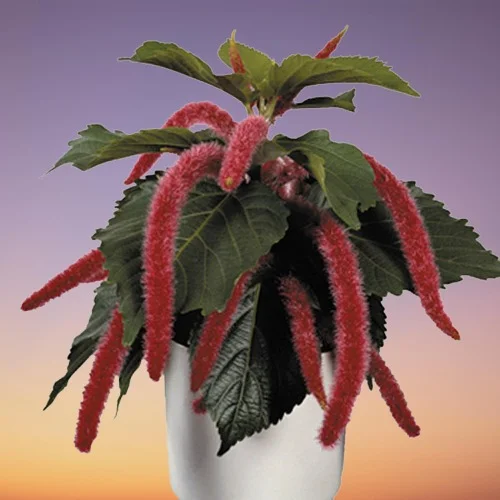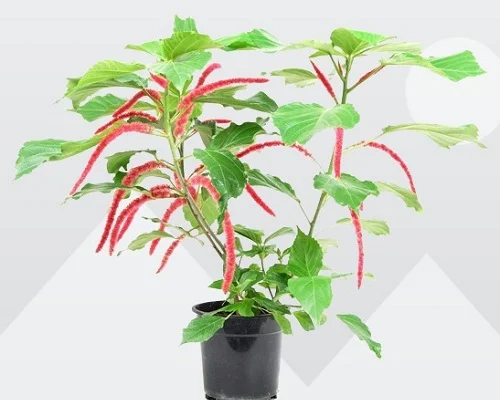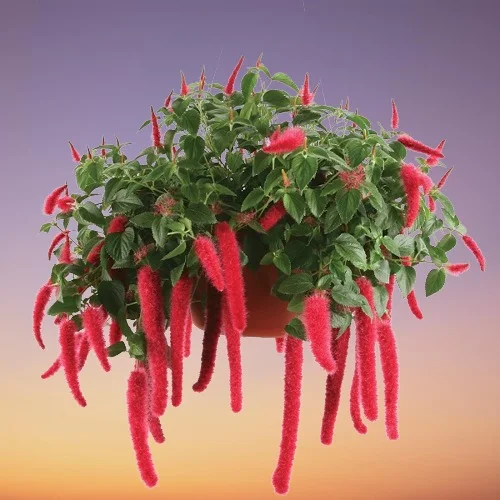How to Propagate Acalypha hispida ( Chenille Plant) by 2 Easy Methods
Some links in this post may be affiliate links
Acalypha hispida (Chenille Plant) is propagated from stem cuttings at the beginning of the growing season and can be rooted either in soil or in water.
Chenille Plant is a popular indoor plant on account of its pendulous, brilliantly colored, furry flowers which make it great for a hanging basket or a pedestal. It has gained the Royal Horticultural Society's Award of Garden Merit because of its attractiveness and brilliantly colored, furry flowers.
Chenille Plant also called Red Hot Cat Tail thrives in bright indirect light, average warmth of 18-280C, humidity of 55-70% and moderately moist, rich, well drained soil coupled with fortnightly feeding in the growing season. Learn how to grow and care for Acalypha hispida.
We have herebelow outlined 2 ways of propagating Chenille Plant. Keep reading to learn how to successfully multiply this spectacular flowering plant.

1. Propagating Acalypha hispida from stem cuttings in water
- Take 4-5 inch stem cuttings from a healthy plant while making sure that it has at least 2 leaves and 2-3 leaf nodes as this is where new growth will come from.
- Strip off the lower leaves and dip the lower cut end in a rooting hormone to hasten rooting.
- Place the cuttings in a jar of plain water or in a propagation station. Place the set up in a warm, well-lit spot away from direct sunlight. Change the water every 5-7 days.
- When a good amount of roots have formed on the cuttings, transfer the cuttings into individual pots in moist, rooting soil.
- Position the set up in a warm, well-lit place away from direct sunlight to prevent scorching.
- Maintain the soil moist until new growth has emerged and substantial growth has been observed.
- Transfer the new plant into a pot 1 size larger than the current one and well-drained soil after which you can begin routine care.
2. Propagating Acalypha hispida from stem cuttings in soil
- Take 4-5 inch stem cuttings from a healthy plant while ensuring that it has at least 2 leaves and 2-3 leaf nodes as this is where new growth will come from.
- Strip off the lower leaves and dip the lower cut end in a rooting hormone to hasten rooting.
- Select a rooting container and ensure that it has adequate drainage to prevent the soil from getting soggy as it can cause rotting of the cutting.
- Fill the container with free-draining potting mix and make a hole in the center. Ensure that the hole is slightly wider than the base of the stem cutting.
- Insert about 2-3 inches of the lower cut end of the stem cutting in the previously made hole and slightly firm the soil around the stem cutting while taking care not to bury it too deep.
- Water the soil thoroughly. To hasten rooting of the cutting, create a greenhouse effect by covering the set up with a clear polythene sheet or bag.
- Ensure the leaves of the cutting do not touch the sheet or bag too much by propping it up with sticks.
- Place the set up in warm, well-lit spot and maintain the soil moist through out until new growth emerges. New growth indicates the cutting has rooted.
- In about 2-3 weeks, rooting of the cutting will have taken place.
- Gradually, over a period of two weeks, remove the plastic bag cover to acclimatize the new plant.
- In about 4-6 months, there will be adequate plant growth and you can begin routine care.
Frequently Asked Questions
1. Can you propagate Chenille Plant in water?
Yes. Chenille Plant can be easily propagated from stem cuttings at the beginning of the growing season either in water or in soil.
2. How do you start a Chenille Plant?
A Chenille Plant can be started from stem cuttings at the beginning of the growing season. Propagating the plant at the beginning season allows adequate time for the growth and development of the new plant.
3. How to root Chenille Plant?
Chenille Plant cuttings can be rooted either in water or in soil. However, rooting in water may take a longer time than rooting in soil.
4. Is Chenille Plant poisonous?
No. As outlined by ASPCA, Chenille Plant is non-toxic to both humans and pets. The plant is safe to grow in the home.
5. How do you take care of Chenille Plant?
Chenille Plant requires bright indirect light (dappled light), average warmth of 18-280C, humidity of 55-70% and moderately moist, fertile, well-drained soil.
You liked it? Share on social media.
Related Content
Amazon Associates Disclosure
Homeplantsguide.com is a participant in the Amazon Services LLC Associates Program, an affiliate advertising program designed to provide a means for sites to earn advertising fees by advertising and linking to amazon.com.





